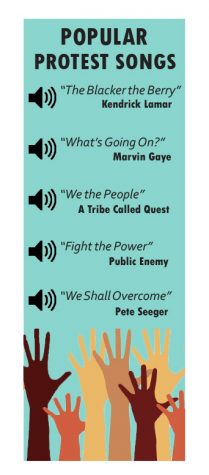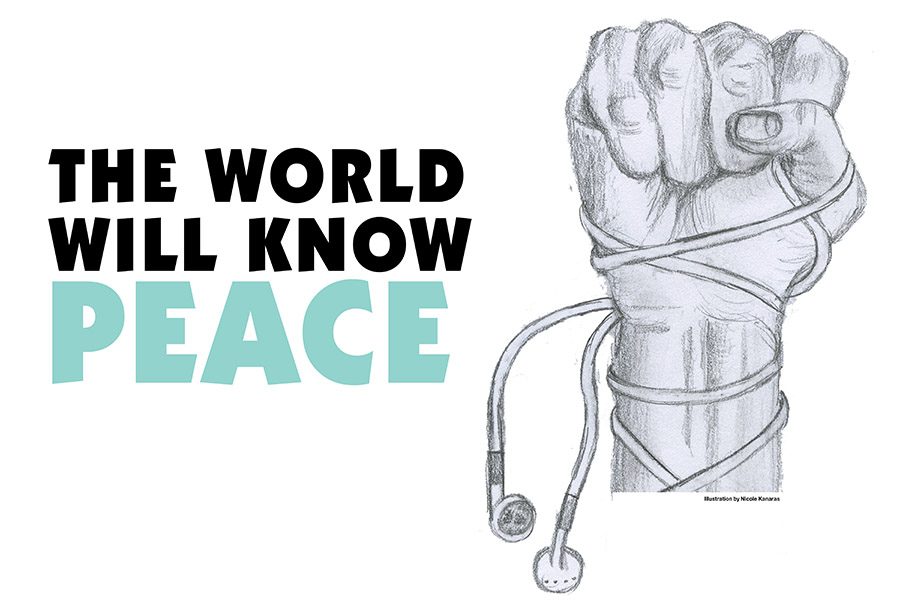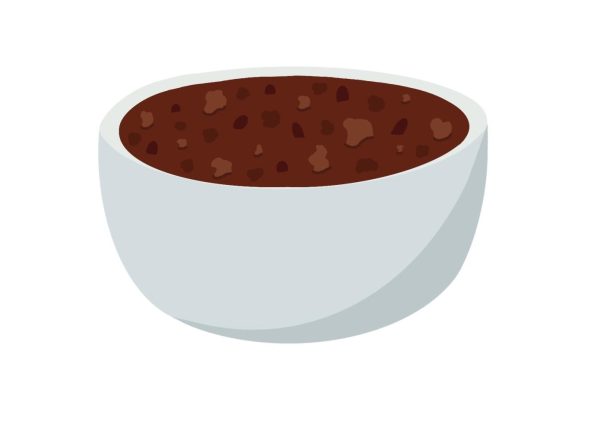Protest music continues to spread the message of peace
Illustration by Nicole Kanaras
Since the 1960s, musicians like Bob Dylan and Jimi Hendrix have used inspirational tunes to spread the message of peace, love, and equality. This form of music continues to be an outlet for artists to connect with the world in a non-violent way.
Junior Evan Tridone sits back, turns his music up, and opens his mind. Currently playing is the YG album, “Still Brazy,” which was released in 2016. Tridone enjoys a variety of rap music, especially those songs and albums with a political edge.
“The advantage of music is you’re getting information straight from someone, not some random journalist. Music can have a big impact on the public opinion of things,” Tridone said. “‘Still Brazy’ was put out in June, and it heavily addressed political issues. It protested strongly against Donald Trump specifically and gave me insight into why people feel the way they do.”
Since its origin, music has served to connect people emotionally and to express creativity and artistic vision. Music has the unique ability to unite and showcase commonality between seemingly differing groups of people. This immense power is found especially in a style known as protest music of which “Still Brazy” is an example.
The movement became especially popular during the 1960s in the form of folk music. Artists such as Bob Dylan, Joan Baez, and the American folk group called Peter, Paul and Mary spoke out against American involvement in the Vietnam War as well as civil rights concerns.
The songs of the era including “Blowin in the Wind” and “The Times They Are a Changin’,” both written by Bob Dylan, are still heard in the cries of the oppressed 50 years later. “‘Blowin in the Wind’ is such an anthem. Bob Dylan generally was extremely powerful,” Religion Department Chair Dr. Joseph Gallen said.
In the 1970s, protest music moved from acoustic stylings towards other genres including reggae, r&b, and punk. The 1980s saw a massive increase in protest music due to disapproval of the Reagan administration, police brutality, and American poverty. Punk and hip-hop dominated the era with artists such as Dead Kennedys, Public Enemy, and N.W.A.who all addressed the faults of the time.
Protest music of the 1990s was lead by the rap-metal band Rage Against the Machine that brought a new level of anger and intensity to the scene. The rest of that decade into the 2000s was dominated by pop-punk band Green Day, as well as rappers Eminem, Mos Def, and Lupe Fiasco. The 2010s have seen a major resurgence of protest music, especially in the hip-hop community. Major racial tensions and political failings have given artists ample opportunities to spread a message of change.
Protest music is a way for artists to shed light on issues they deem important and give their listeners a voice. Often, protest music is used as a tool for social change and covers a variety of topics ranging from environmental degradation to political strifes.
According to social studies teacher Rodney Johnson, “Protest music reflects the injustices that the artists want to raise awareness to … For it to be effective, it helps if someone big puts themselves out there for what they are protesting against.”
Junior Scott Gray shares a similar definition of what protest music truly means. “Music that showcases artists using their platform as a way to express their political views,” Scott said. Music that showcases artists using their platform as a way to express their political views — Scott Gray
According to Tridone, protest music gives him a new perspective on social issues. “I might have a preconceived notion about something, and I’ll hear a song by Kendrick Lamar, Run the Jewels, or YG that discusses the topic and I’ll be opened to a whole new viewpoint. These people have really gone through tough times and can speak authentically about issues through protest music,” Tridone said.
According to Gallen, protest music has a distinct ability to capture the feelings and thoughts of various time periods. It can be used as a reference point to understand feelings of unrest and motivations for change. “When I think of the way we look back on history, I think there are songs we associate with events. Songs conjure themes of the era and capture events,” Gallen said.
Protest music, while having undergone drastic sonic changes, still serves the same purpose; to challenge conventions of society, bring about change, and shed light on major issues. Most of all, it unites and entertains the listeners who need a voice.
“Protest music raised my awareness and forced me to not be complacent. It’s important to be aware of what’s going on and to think about human rights and race relations,” Johnson said.
https://play.spotify.com/user/thejcpatriot/playlist/7w96ajaxgiVbaUGPOMwJSI
Edward Benner is a News Editor for The Patriot and jcpatriot.com.





